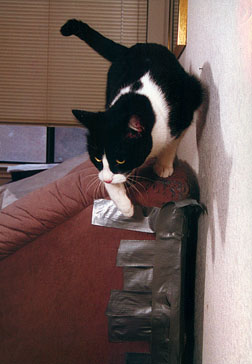Do you have to explain to guests why your red velvet sofa has homemade, blue-checked arm covers that barely cover the damage beneath? Then perhaps its time to train your cat to use a scratching post. This is a painless way to stop a too-common problem: damage to household furniture or draperies caused by claw scratching.

252
Scratching is a natural behavior that also does your cat some good. Benefits include marking her territory with a scent from her footpads; removing the dead outer sheaths on her front claws; and getting stress-reducing, muscle-stretching exercise.
While engaged in scratching, a cat is very much enjoying herself – so the challenge to the owner is to permit the scratching to continue without shredding the household furnishings.
The good news is that cats are smart and like to please their owners. Usually a combination of positive and negative reinforcement quickly stops furniture scratching and moves your cat to happy workouts on her personal scratching post.
Start When Theyre Young
The key is to start cats in their youth, so you dont have to train them away from furniture-scratching behavior they may have already started, says James Richards, DVM, director of the Cornell Feline Health Center.
Although starting with a kitten is best, cats of all ages can generally be trained to use a post and stay away from the furniture. Begin by taking your cat or kitten to the post several times a day, after naps or whenever she appears to be considering a workout on the family furniture.
If you find your cat or kitten scratching in an unapproved area, quickly clap, blow a whistle or shake a soda can filled with coins to interrupt the scratching. The point is not to frighten or punish her – but to get her attention, stop the behavior and keep your interactions positive.
Now gently guide your cat to her scratching post and encourage her to scratch, perhaps by gently holding her paws up to the post. For the next few weeks, follow up with plenty of petting and praise every time she scratches the post.
To enhance the scratch me attraction of the post, keep it in a convenient place for your cat, such as near her favorite sleeping spot or food bowl. Many cats like to scratch after a nap or a meal. Putting the post in a remote spot is an out-of-sight, out-of-mind mistake that could easily put the sofa back on top of the list of favorite scratching sites.
Make It Appealing
To increase the posts allure, attach a catnip mouse to it, rub it with catnip or give it a dose of catnip spray – presuming your cat is attracted to catnip. (About one-third of all cats dont react to it.) Pulling a toy playfully up the post is another good way to build the bond between the cat and her post.
To ensure that she doesnt go back to the original scratched furniture site, use an enzyme odor remover to eliminate the territorial scent and spray the spot with a pet repellent sold at pet supply stores. You can also temporarily block access to the spot with objects such as a piece of plywood, cardboard, self-stick paper, a sheet or aluminum foil. A couple weeks of these efforts and the furniture-scratching habit should be broken.
However, if your cat is especially resistant to behavioral change and your new sofa may be the next victim, try confining her for a few days in a room with no scratching surfaces other than her new scratching post.
What To Look For
The best posts have several qualities in common. Cats enjoy bracing themselves and tearing into whatever they scratch, so a sturdy post that wont wobble is basic.
Since cats like to reach upward and pull down, a post tall enough for your cat to use while standing on her hind legs (without reaching the top) is preferable. Dr. Richards recommends using a couple of scratching posts if you have several cats or a large home.
When it comes to the posts surface, a horizontal grain is most compatible with the downward pulls. Posts covered with sisal, a rugged carpet or a carpet with the backing exposed are welcomed by most cats. Fluffy coverings may not provide the necessary resistance for a good workout and could send your cat back to the couch.
Another tip from Dr. Richards is to note what scratching surfaces your cat prefers and use that material on her post. In some cases, a bare wood post – or even a log with the bark still on – in addition to the carpeted post, is the answer.
Some cats are horizontal scratchers. To meet their needs, build or buy a flat scratching pad to lay on the floor. There are boxes of corrugated material already scented with catnip that are designed as scratching posts. They can either be stood up or laid on the floor. Theyre inexpensive, so when they start looking shabby you can throw them out and buy a new one. Bear in mind, however, that some cats prefer their shabby posts, so you may want to keep the old one in the closet – in case the cat rejects the new one!



